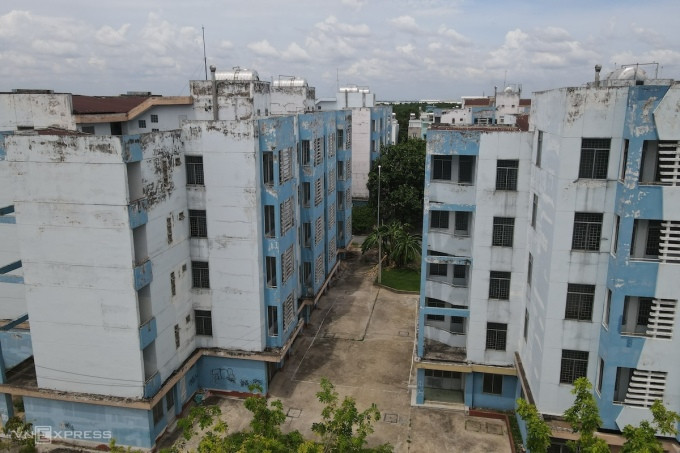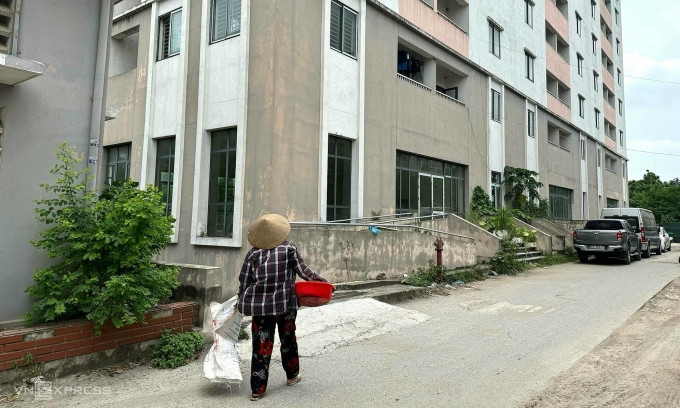Inadequate mechanisms, unrealistic planning, and poor construction quality have left thousands of resettlement apartments in Hanoi and Ho Chi Minh City uninhabited for the past decade.

The family of five, Ms. Le Thi Lien, 62, has lived for decades in a house of about 12 square meters deep in Hang Chieu Alley (Hoan Kiem District, Hanoi). The cramped house was expanded with an additional bedroom in the attic after her son got married.
Being part of the resettlement area from the old town, Ms. Lien said that her family did not want to move to the resettlement area on Ly Son Street (Thuong Thanh Ward, Long Bien District), because it was 7 km away from her old house. She said that the house on Hang Chieu was cramped but was a place where "every inch of land is gold", closely related to making a living.
"Moving 7 km away is very inconvenient and no member wants to move to resettlement housing," said Ms. Lien.
Similarly, the family of Mr. Tran Huu Son, 56 years old, residing in District 6, Ho Chi Minh City, handed over land to the state for the Tan Hoa - Lo Gom canal renovation project in 2012. After the handover, he was compensated with a resettlement apartment at the Vinh Loc B project, Binh Chanh district, 12 km from his old house.
The compensation was not enough to buy a new apartment, so Mr. Son still decided to accept the money instead of receiving the house. He said that "the resettlement area is too far away, affecting his family's livelihood". According to Mr. Son, some people who were subject to clearance quickly sold their houses and left, few people chose to stay and create a new life.
The resettlement areas for the Old Quarter in Thuong Thanh and Vinh Loc B wards are two of the apartment buildings that have been abandoned for many years in Hanoi and Ho Chi Minh City. These two cities currently have nearly 13,000 resettlement apartments without residents.
According to statistics from the Ho Chi Minh City Department of Construction, there are nearly 9,000 vacant apartments, of which the Binh Khanh resettlement area (Thu Duc City) accounts for more than half. The Vinh Loc B project (Binh Chanh District) accounts for about a quarter of the city's total vacant resettlement apartments.
Resettlement housing is a type of housing provided by the State to compensate when land is recovered from people, helping them have a stable place to live. However, the situation of thousands of unoccupied houses in Hanoi and Ho Chi Minh City - where the demand for housing is very urgent, the supply is constantly in short supply, creating a very wasteful paradox.
The reasons pointed out by many experts are that the resettlement compensation mechanism has been inadequate for many years, planning has not closely followed people's needs and construction quality has rapidly deteriorated.
Loopholes in the compensation and resettlement support mechanism have led to a situation where houses are built but no one moves in. According to the 2013 Housing Law, people whose land is confiscated by the State will receive compensation in the form of land, pre-built houses or money.
Mr. Le Hoang Chau, Chairman of the Ho Chi Minh City Real Estate Association (HoREA), said that most people whose land was confiscated would take compensation money instead of choosing to receive a house. Because in many localities, people have to pay an additional amount of infrastructure investment, up to several hundred million VND, to be able to exchange houses.
For example, in an island city, people have to pay an additional VND3 million per square meter to receive a resettlement house. If they are compensated for a 100 square meter house, they have to pay an additional VND300 million. Some localities even charge up to VND7 million per square meter, meaning the amount of money people have to pay can be up to VND700 million if they want to exchange houses.
The leader of a real estate management and development company in Hanoi said that the 2013 Land Law stipulates that compensation prices for land acquisition must follow the annual price list approved by the Provincial People's Council. Meanwhile, the price of land and resettlement housing is approved by the Provincial People's Committee for each project. This leads to a situation where compensation prices are often lower than the market price, causing households in the clearance area to not have enough money to buy houses.
"This problem causes most people to receive money and then try to buy commercial housing. Many resettlement buildings are completed but no one lives there," he said.
Not to mention, resettlement housing planning has not closely followed people's needs. Architect Dao Ngoc Nghiem, Vice President of the Vietnam Urban Planning and Development Association, acknowledged that most resettlement buildings are located far away, lacking connection with the cleared land, such as the 5 buildings serving the old quarter's population dispersion.
"The location in Long Bien is more spacious, but people don't know what business to do or what their income is. In the old quarter, they can earn tens of millions per month even though their living space is only a few square meters," he said.
According to Mr. Nghiem, when setting up the resettlement project, the management agency and the investor did not survey the opinions and needs of the people whose land was recovered. Instead, the authorities only "informed them that they had to move to a place that had already been built". This led to the project being completed but only meeting the housing needs, not taking into account jobs, cultural environment, and suitable infrastructure.

Poor construction quality and lack of basic amenities also make many people indifferent to resettlement housing. Mr. Nguyen Van Dinh, Chairman of the Vietnam Association of Realtors (VARS), said that most resettlement projects have problems with construction quality such as using poor materials, unreasonable design and substandard construction.
Many projects have seriously degraded after decades of operation but lack funds for maintenance. This problem affects the safety of residents and reduces the value of the apartments.
For example, statistics from the Ho Chi Minh City Department of Construction show that the management and operation fees of abandoned resettlement projects amount to over VND81 billion, which have not been paid. The reason is that the Center for Housing Management and Construction Inspection - the unit managing 8,500 out of 9,000 resettlement apartments - has not been authorized by the Ho Chi Minh City People's Committee to elect a management board and agree on management and operation prices for empty apartments.
In Hanoi, the management and operation fee for resettlement housing is about 30,000 VND per household per month (about 500 VND/m2). This level has remained unchanged for the past 15 years.
A representative of the Hanoi Housing Management and Development Company Limited - the unit assigned to manage nearly 170 resettlement houses in the capital, admitted that most of the resettlement houses in the area are seriously degraded, with signs such as peeling walls, water seepage, broken tile floors, malfunctioning elevators... One of the reasons is that the operating and management fees are too low, and have not been increased for more than ten years, leading to the reality that "it is not enough to maintain and make basic repairs for degraded buildings".
According to architect Dao Ngoc Nghiem, many resettlement areas are planned in "deserted" areas. These places lack basic infrastructure such as schools, hospitals, markets... and do not ensure quality of life, so it is difficult to "attract" people to live there.
Ms. Le Thi Lien said that she had considered several times moving out of her cramped house in the old quarter to a more spacious and comfortable resettlement house. After visiting the new residential area in Thuong Thanh ward with her son - the place for the second phase of the old quarter resettlement - she immediately changed her mind.
"The quality of the houses has seriously degraded, no one lives there, and there are few amenities despite being close to a main road, making the new environment not much better than the old quarter," she said.
Faced with the above situation, Prime Minister Pham Minh Chinh assigned the Ministry of Construction to study the conversion of unused resettlement apartments to social housing in a meeting to resolve difficulties in mid-May. This solution is expected to promote the project to build one million social housing apartments, solving the large number of resettlement houses that have been abandoned and wasted for many years.
TB (according to VnExpress)